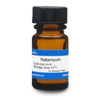Natamycin is a natural small molecule. It is an antifungal polyene macrolide that binds to ergosterol and blocks fungal growth, without changing the permeability of the plasma membrane. It was isolated in 1955 from fermentation broth of Streptomyces natalensis cell culture from Pietermaritzburg (Natal, South Africa). It is effective against fungi causing ophthalmological complications and is also used commercially to prevent food spoilage.
| Application | Natamycin can be used as an analytical reference standard. It is also used as a food preservative as an alternative to sorbic acid. |
| Mechanism of Action | Natamycin binds membrane-bound ergosterol preventing carbohydrate and amino acid transportation by vacuole and membrane mediated fusion. Natamycin does not inhibit synthesis of ergosterol. Unlike Amphotericin B which disrupts fungal membranes directly, Natamycin disrupts ergosterol-dependent membrane transport. |
| Spectrum | Natamycin targets fungi responsible for causing ophthalmological complications especially Fusarium species. It is also effective for Candida, Aspergillus, Cephalosporium, and Penicillium. It is not effective against bacteria. |
| Microbiology Applications | Isolated vacuoles from yeast were used as a model system to show that Natamycin was able to inhibit vacuolar homotypic fusion. Natamycin acted even before membrane contact, and the activity was dependence on specific chemical features in the ergosterol structure, specifically the presence of double bonds in the B-ring at the 7,8 position of sterol (te Welscher et al, 2010). |
| Plant Biology Applications | Anthracnose crown rot of strawberry, caused by Colletotrichum acutatum, is an important fungal pathogen. Industry standard treatments is a preplant dip treatment with azoxystrobin or fludioxonil-cyprodinil, but high levels of quinone outside inhibitor (Qol) resistance has been detected, which was found to be associated with the G143A mutation in the cytochrome b gene. Natamycin was investigated, and dip treatments at 500 or 1000 mg/L were highly effective in limiting disease severity and plant mortality to the low levels seen with fludioxonil, while significantly increasing fruit yield compared to controls (Haack et al, 2018). |
| Solubility | Freely soluble in DMSO and glacial acetic acid. Sparingly soluble in water. |
| References |
Ghannoum MA and Rice LB (1999) Antifungal agents: Mode of action, mechanisms of resistance, and correlation of these mechanisms with bacterial resistance. Clin. Microbiol. Rev. 12(4):501-517 Haack SE, Ivors KL, Holmes G, Förster H and Adaskaveg JE (2018) Natamycin, a new biofungicide for managing crown rot of strawberry caused by Qol-resistant Colletotrichum acutatum. Plant Dis. 102(9): 1687-1695 PMID 30125151 te Welscher YM et al (2009) Natamycin inhibits vacuole fusion at the priming phase via a specific interaction with ergosterol. Antimicrob. Agents Chemother. 54(6):2618-2625 |



